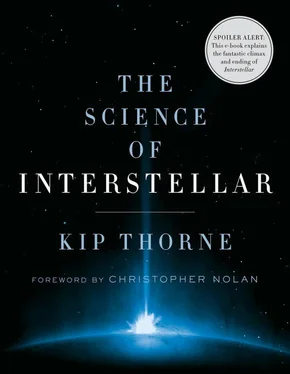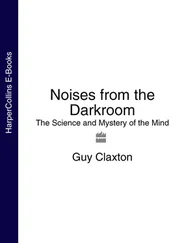Einstein’s laws dictate that, as seen from afar, for example, from Mann’s planet, Miller’s planet travels around Gargantua’s billion-kilometer-circumference orbit once each 1.7 hours. This is roughly half the speed of light! Because of time’s slowing, the Ranger’s crew measure an orbital period sixty thousand times smaller than this: a tenth of a second. Ten trips around Gargantua per second. That’s really fast! Isn’t it far faster than light? No, because of the space whirl induced by Gargantua’s fast spin. Relative to the whirling space at the planet’s location, and using time as measured there, the planet is moving slower than light, and that’s what counts. That’s the sense in which the speed limit is enforced.
In my science interpretation of the movie, since the planet always keeps the same face pointed toward Gargantua (Figure 17.4), it must spin at the same rate as it orbits, ten revolutions per second. How can it possibly spin so fast? Won’t centrifugal forces tear it apart? No; and again the savior is the whirl of space. The planet would feel no disruptive centrifugal forces if it were spinning at precisely the same rate as space near it whirls, which it is almost doing! So centrifugal forces due to its rotation, in fact, are weak. If, instead, it were nonspinning relative to the distant stars, it would turn at ten revolutions per second relative to whirling space and so would be torn apart by centrifugal forces. It’s weird what relativity can do.
Giant Waves on Miller’s Planet
What could possibly produce the two gigantic water waves, 1.2 kilometers high, that bear down on the Ranger as it rests on Miller’s planet (Figure 17.5)?
I searched for a while, did various calculations with the laws of physics, and found two possible answers for my science interpretation of the movie. Both answers require that the planet be not quite locked to Gargantua. Instead it must rock back and forth relative to Gargantua by a small amount, from the orientation on the left of Figure 17.6, to that on the right, then back to the left, and so on.
This rocking is a natural thing, as you can see by looking at Gargantua’s tidal gravity.
In Figure 17.6, I describe the tidal gravity by tendex lines (Chapter 4). No matter which way the planet is tilted (left or right in Figure 17.6), Gargantua’s blue squeezing tendex lines push its sides in, which drives the planet back toward its preferred orientation, the one with its bulges nearest Gargantua and farthest away (Figure 17.3). Similarly, Gargantua’s red stretching tendex lines pull its bottom bulge toward Gargantua and push its top bulge away from Gargantua. This also drives the planet back toward its preferred orientation.

Fig. 17.5. A giant water wave bearing down on the Ranger. [From Interstellar , used courtesy of Warner Bros. Entertainment Inc.]
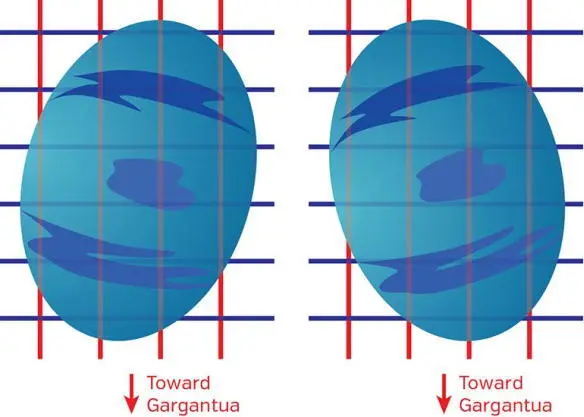
Fig. 17.6. The rocking of Miller’s planet in response to Gargantua’s tidal gravity: its stretching tendex lines ( red ) and squeezing tendex lines ( blue ).
The result is a simple rocking of the planet, back and forth, if the tilts are small enough that the planet’s mantle isn’t pulverized. When I computed the period of this rocking, how long it takes to swing from left to right and back again, I got a joyous answer. About an hour. The same as the observed time between giant waves, a time chosen by Chris without knowing about my science interpretation.
The first explanation for the giant waves, in my science interpretation, is a sloshing of the planet’s oceans as the planet rocks under the influence of Gargantua’s tidal gravity.
A similar sloshing, called “tidal bores,” happens on Earth, on nearly flat rivers that empty into the sea. When the ocean tide rises, a wall of water can go rushing up the river; usually a tiny wall, but very occasionally respectably big. You can see an example in the top half of Figure 17.7: a tidal bore on the Qiantang River in Hangzhou, China, in August 2010. Though impressive, this tidal bore is very small compared to the 1.2-kilometer-high waves on Miller’s planet. But the Moon’s tidal gravity that drives this tidal bore is tiny—really tiny—compared to Gargantua’s huge tidal gravity!
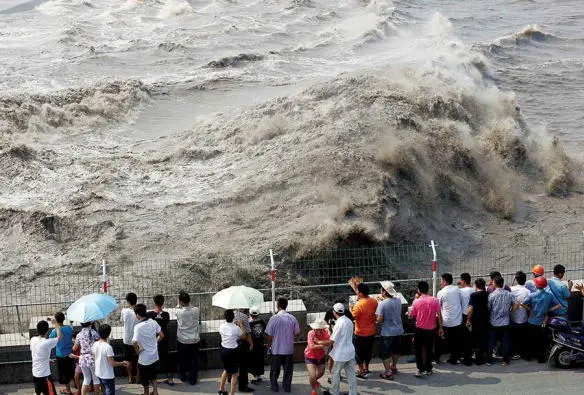

Fig. 17.7. Top : A tidal bore on the Qiantang River. Bottom : A tsunami in Miyako City.
My second explanation is tsunamis. As Miller’s planet rocks, Gargantua’s tidal forces may not pulverize its crust, but they do deform the crust first this way and then that, once an hour, and those deformations could easily produce gigantic earthquakes (or “millerquakes,” I suppose we should call them). And those millerquakes could generate tsunamis on the planet’s oceans, far larger than any tsunami ever seen on Earth, such as the one that hit Miyako City, Japan, on March 11, 2011 (bottom half of Figure 17.7).
Past History of Miller’s Planet
It is interesting to speculate about the past and future history of Miller’s planet. Try it using as much physics as you know or can scrounge up from the web or elsewhere. (This is not easy!) Here are some things you might think about.
How old is Miller’s planet? If, as an extreme hypothesis, it was born in its present orbit when its galaxy was very young (about 12 billion years ago), and Gargantua has had its same ultrafast spin ever since, then the planet’s age is about 12 billion years divided by 60,000 (the slowing of time on the planet): 200,000 years. This is awfully young compared to most geological processes on Earth. Could Miller’s planet be that young and look like it looks? Could the planet develop its oceans and oxygen-rich atmosphere that quickly? If not, how could the planet have formed elsewhere and gotten moved to this orbit, so close to Gargantua?
How long can the planet’s rocking continue until friction inside the planet converts all the rocking energy to heat? And how long could it have rocked in the past? If a lot shorter than 200,000 years, then perhaps something set it rocking. What could have done so?
When friction converts rocking energy to heat, how hot does the planet’s interior get? Hot enough to trigger volcanos and lava flows?
Jupiter’s moon Io is a remarkable example of this. Io, the large moon that orbits closest to Jupiter’s surface, doesn’t rock. But it does move closer and farther from Jupiter along an elliptical orbit, so it feels Jupiter’s tidal gravity strengthen then weaken then strengthen, much like Miller’s planet feels Gargantua’s tidal gravity oscillate. This heats Io enough to produce huge volcanos and lava flows (Figure 17.8).
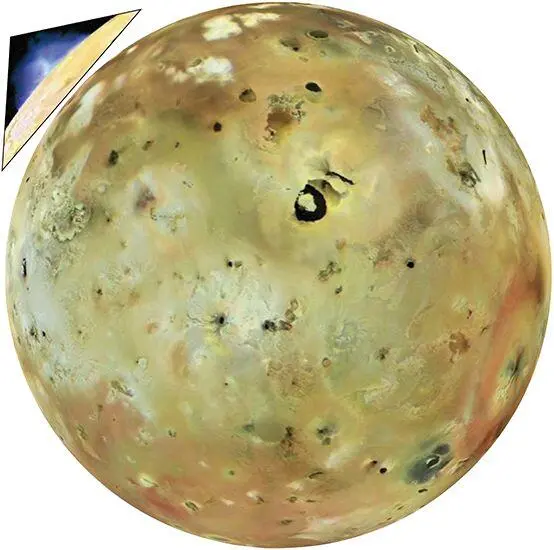
Fig. 17.8. Io as photographed by the Galileo spacecraft shows many volcanos and lava flows. Inset : A 50-kilometer-high volcanic plume.
The Appearance of Gargantua from Miller’s Planet
In Interstellar , as the Ranger approaches Miller’s planet carrying Cooper and his crew, we see Gargantua in the sky above, 10 degrees across (twenty times larger than the Moon as seen from Earth!) and surrounded by its bright accretion disk. See Figure 17.9. As startlingly impressive as this may be, Gargantua’s angular size has actually been reduced greatly from what it would really be at the location of Miller’s planet.
Читать дальше
